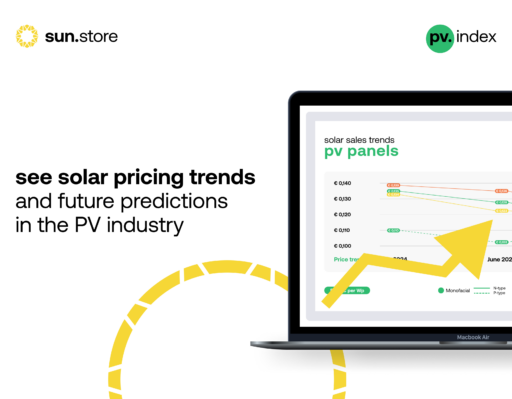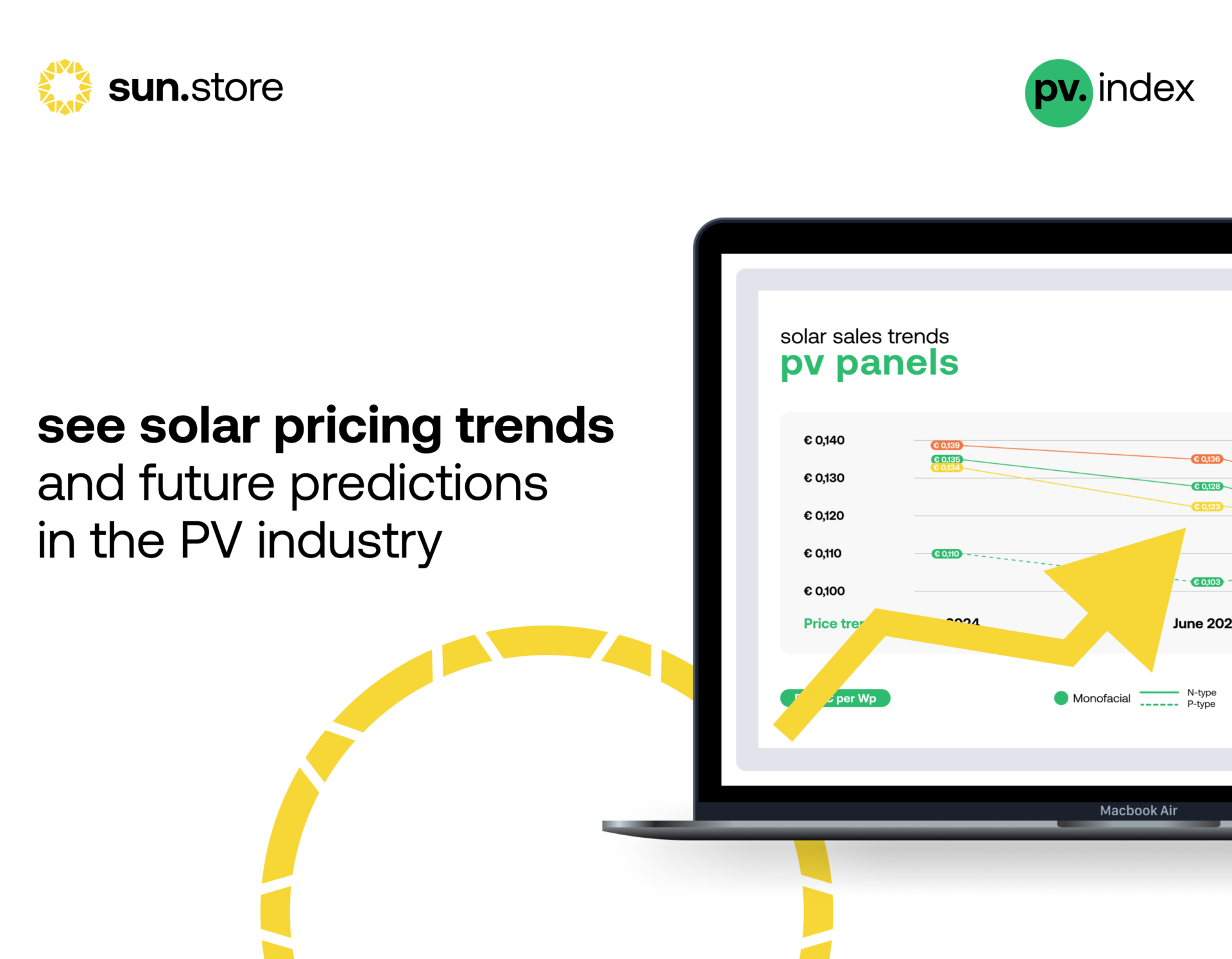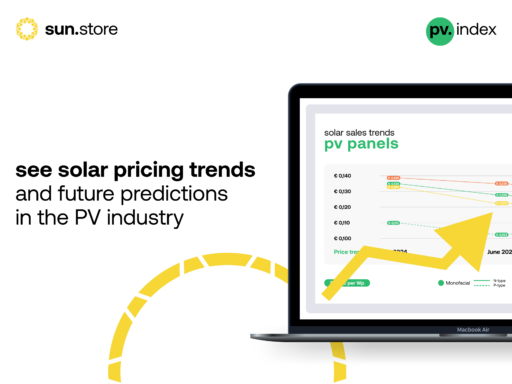Jinko takes the top spot, Huawei leads string inverters, and PV sentiment dips
sun.store shares July data as European installers push through peak season
As Europe’s largest digital marketplace for solar components, sun.store continues to provide transparency into the PV supply chain. With over 30,000 registered users and more than 1 GW of traded components, our monthly PV Index remains a key resource for installers, traders, and manufacturers looking to benchmark prices and understand purchasing behavior across Europe.
In this latest edition, covering July 2025, we observe a continuation of the market’s summer trend: slightly lower demand, price corrections, and growing brand competition — particularly in panels and string inverters. Buyer sentiment shows decline, hinting at a more cautious outlook heading into late Q3.
Solar panel prices shift slightly – Jinko regains the lead
In July, average module prices continued to fluctuate moderately, reflecting a market still shaped by summer seasonality and uneven availability. Monofacial N-type modules recorded a 2% price drop, settling at an average of €0.095/Wp — their second consecutive month of decline, indicating ongoing price pressure and relatively stable supply.
In contrast, Monofacial P-type modules saw a slight increase of 1%, reaching €0.084/Wp. This uptick likely reflects tighter availability in budget segments, particularly for smaller-volume orders.Bifacial N-type modules mirrored the trend seen in N-type monofacials, also declining by 2% to €0.099/Wp, while Full Black modules experienced the most significant price movement. Their average price rose by 3% to €0.105/Wp, driven by residential demand and reduced availability of visually uniform SKUs, which remain popular among installers focused on aesthetics.
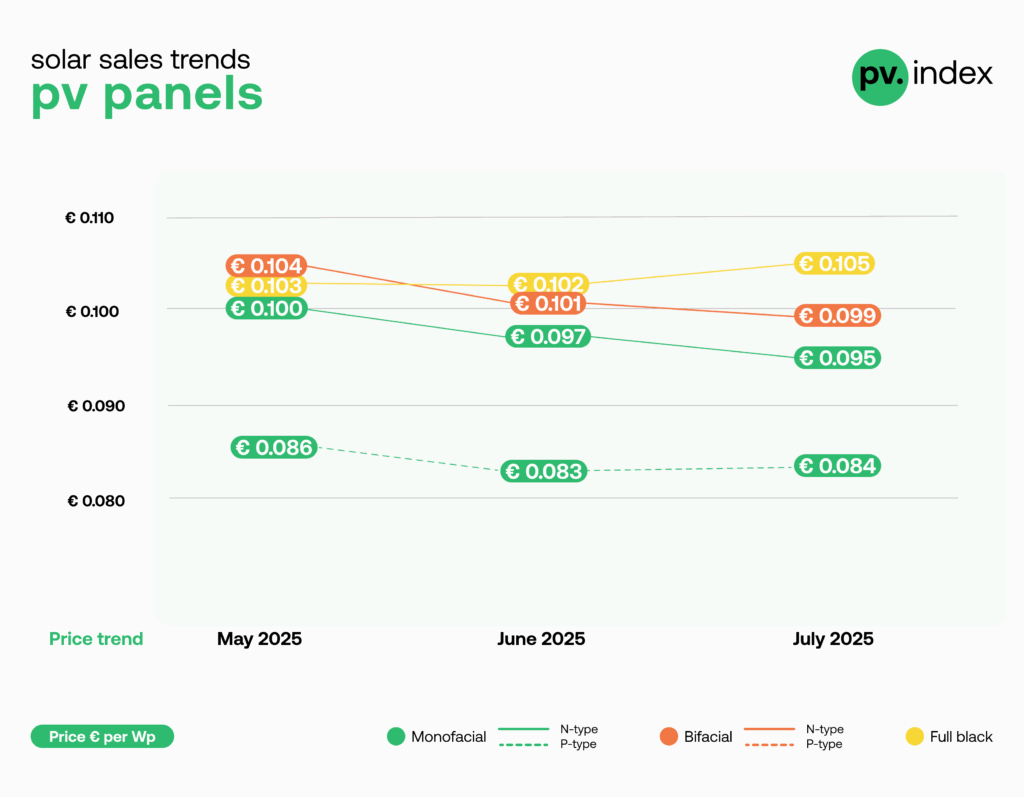
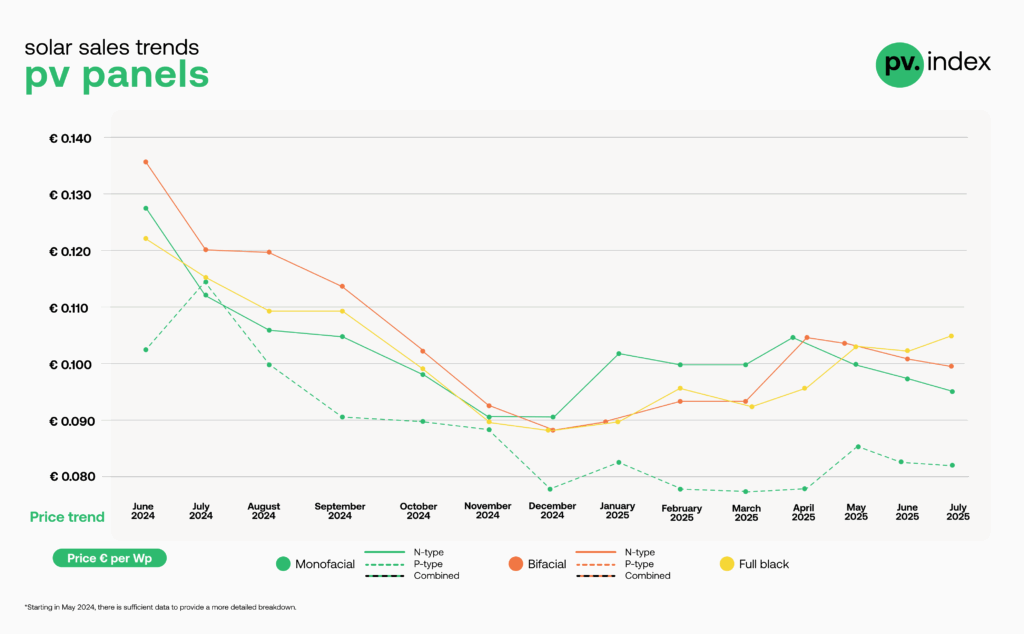
The biggest shake-up came in the brand rankings. After several months of climbing, Jinko has reclaimed the number one spot as the top-selling panel brand on sun.store, overtaking Trina and others thanks to wider availability and strong pricing. LONGi and JA Solar continue to perform strongly. Aiko remains in the top five despite a significant decline in transaction volumes which may result in its replacement in the future PV Index editions..
“At sun.store, we have noticed lower availability of residential-size modules across the market. To address this, we are working to secure attractive offers and improve availability for our users. A market favorite that will soon feature more prominently on the platform is JA Solar.”
— Filip Kierzkowski, Head of Partnerships and Trading, sun.store
Top 5 solar panel brands — July 2025
- Jinko
- LONGi
- JA Solar
- Trina
- Aiko
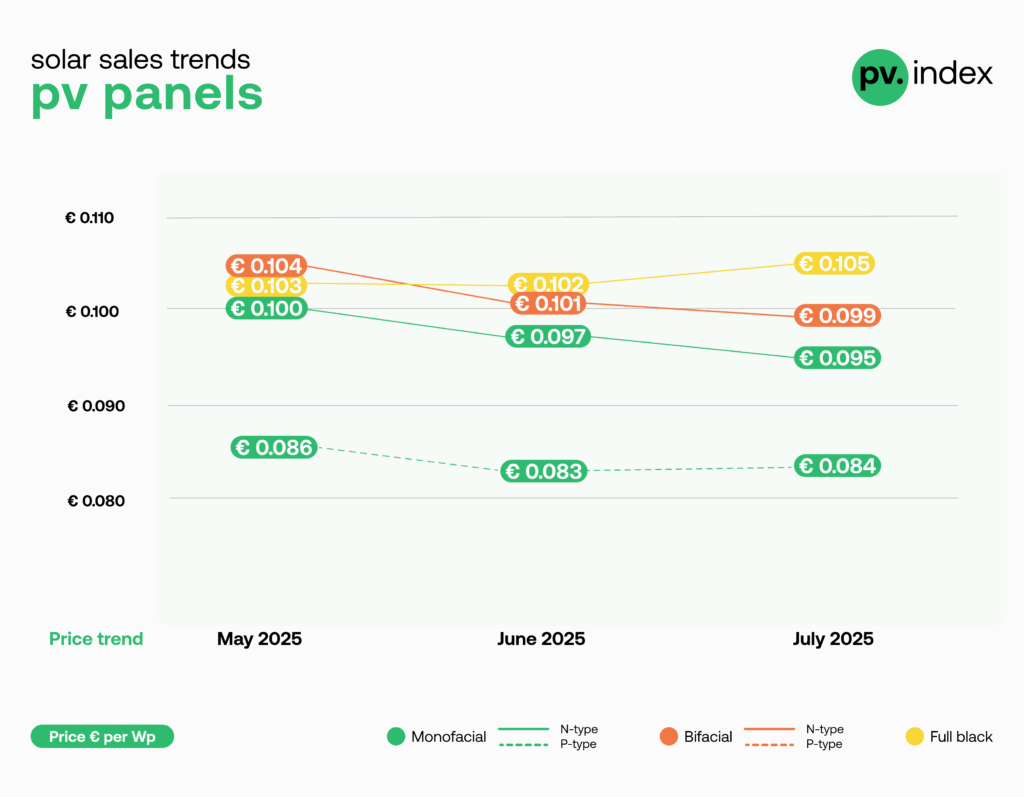
Inverter prices continue to slide, with Huawei and Deye continuing as category leaders
Inverter prices extended their downward trajectory in July, with both hybrid and string models seeing modest declines. This reflects intensifying competition among brands, as well as increasing selectivity on the part of installers and EPCs.
Hybrid inverter systems below 15 kW experienced a 4% price drop, averaging €102.48/kW, while larger systems above 15 kW declined by 2%, reaching €80.55/kW. These price movements point to growing price sensitivity in the mid-size residential and small-commercial segments — particularly where project pipelines remain active but margins are under pressure.
String inverters (previously labeled “on-grid”) followed a similar trend. Units under 15 kW dropped by 4% to €48.37/kW, while those above 15 kW now average €23.91/kW, down 2% month-over-month. Despite these reductions, some top-tier brands are maintaining value thanks to strong after-sales support and shorter lead times — both of which are increasingly prioritised by professional buyers.
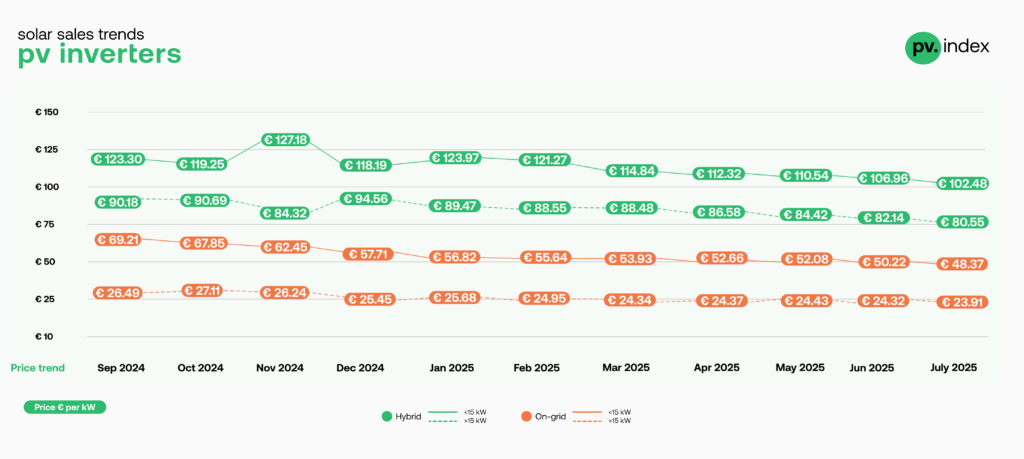
The brand rankings remained largely stable. In the hybrid category, Deye retains the top position, with Sungrow and GoodWe remaining strong contenders. A decline in trading activity for Fronius devices is likely to lead to its replacement in future editions of PV Index.
Huawei continues to dominate the string inverter category, with Solis climbing to second place — a notable shift that highlights growing demand for flexible and cost-efficient systems.
Top 5 hybrid inverter brands — July 2025
- Deye
- Sungrow
- GoodWe
- Huawei
- Fronius

Top 5 string inverter brands — July 2025
- Huawei
- Solis
- SMA
- Sungrow
- SolarEdge
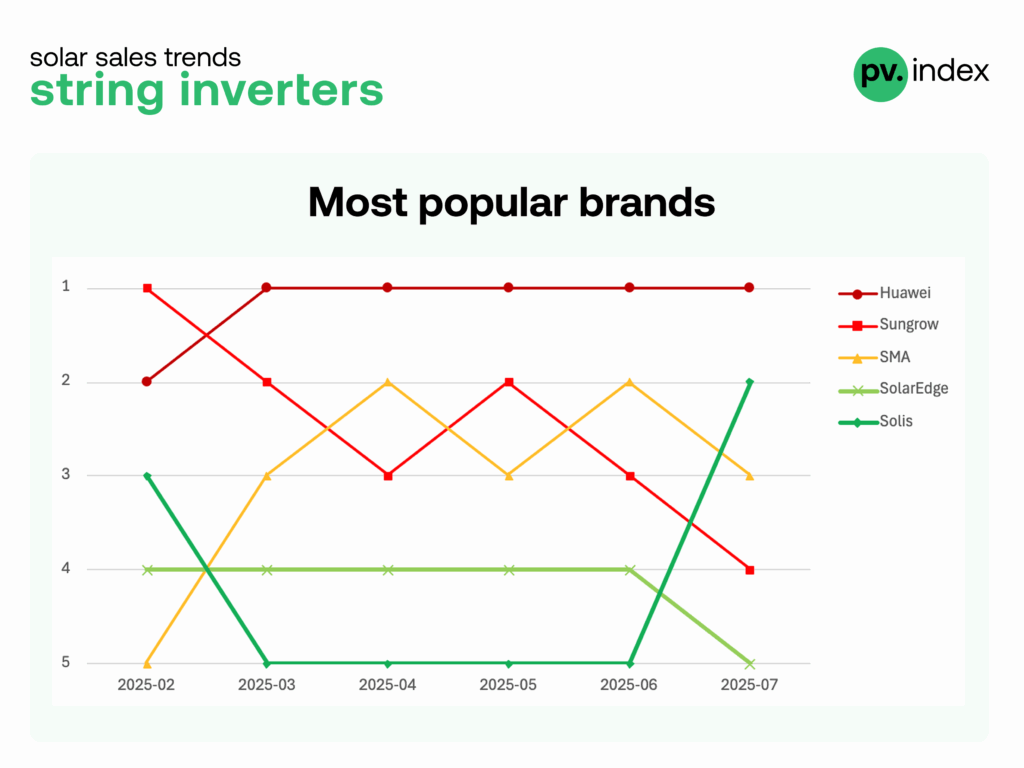
PV PMI: market sentiment drops to 65 — a seasonal pause or something more?
In July, the PV Purchasing Managers’ Index (PV PMI) dropped to 65 – its lowest score since the launch of the index. This 3-point decline from June (68) is consistent with seasonal slowdowns, although last year’s July reading stood at 68. Thus, it is more likely a result of growing caution among buyers navigating a volatile macroeconomic environment. Of the 1,321 sun.store users surveyed this month:
- 46% said they plan to increase purchasing
- 39% expect to maintain current levels
- 15% anticipate a decrease in orders
While the index remains well above the 50-point mark that should indicate expansion, the downward shift reflects a mix of factors. Across Europe, August is traditionally a vacation month, particularly in southern markets — limiting both installer activity and investor responsiveness. At the same time, uncertainty surrounding future component prices, financing conditions, and residential demand appears to be causing hesitation.
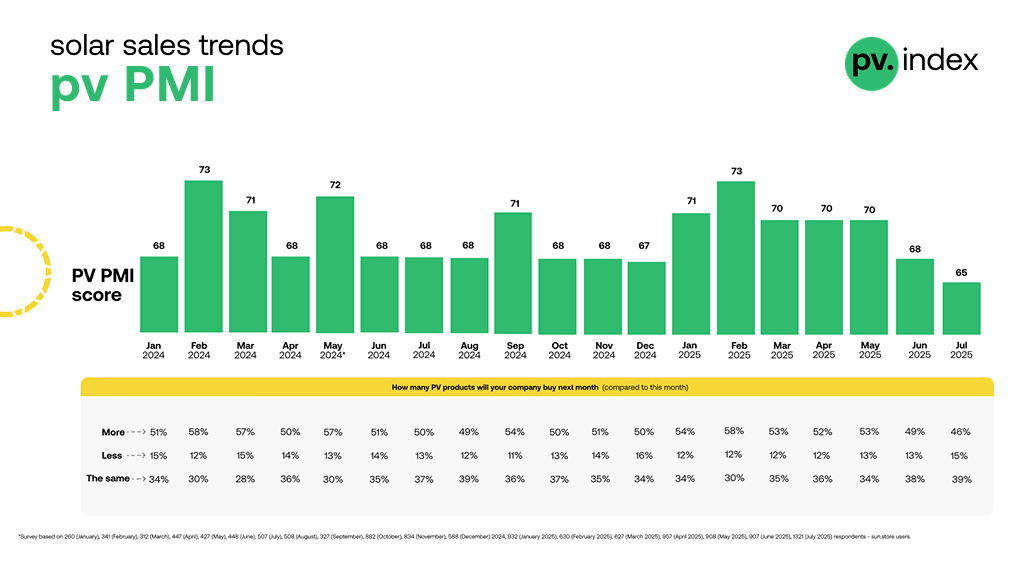
*Calculated as PMI = (P1 * 1) + (P2 * 0.5) + (P3 * 0) — where P1 is improvement, P2 no change, and P3 deterioration — this score highlights a market adapting to supply constraints while gearing up for peak installation season.
“We are currently experiencing a seasonal summer slowdown — a trend observed even among our merchants, many of whom have enabled ‘holiday mode’ on the platform to signal limited availability and communication. Low stock levels and uncertain pricing in the coming weeks are compounding the situation. That said, we are closely monitoring the market to see whether activity picks up sharply in September or if this more cautious sentiment persists.”
— Krzysztof Rejek, VP of Sales, sun.store
Looking ahead, many in the industry are eyeing early autumn as a key turning point. Procurement is increasingly strategic, and buyers are holding off on large-volume commitments in anticipation of clearer price signals post-summer.
Looking ahead: all eyes on September as the market enters a holding pattern
With July behind us and most of Europe entering its traditional summer slowdown, the solar market finds itself in a period of strategic hesitation. Procurement volumes remain stable, but decision-making has slowed – not only due to vacations across southern Europe, but also as buyers pause to reassess pricing trajectories and inventory needs before peak Q4 installations.
While current module and inverter prices appear relatively stable, that balance may prove temporary. S
Major Chinese polysilicon producers recently announced plans to shut down a third of national production capacity by 2027, backed by a government-supported €7 billion fund【source: Reuters, July 31】. Polysilicon and wafer prices are recording upward corrections and there is a widespread consensus that the 9% export rebate will be phased out soon. If the first effects of these changes materialize, prices for upstream components could begin rising as soon as Q4, cascading into module and inverter pricing in Europe.
 EN
EN ES
ES DE
DE PL
PL IT
IT FR
FR GR
GR